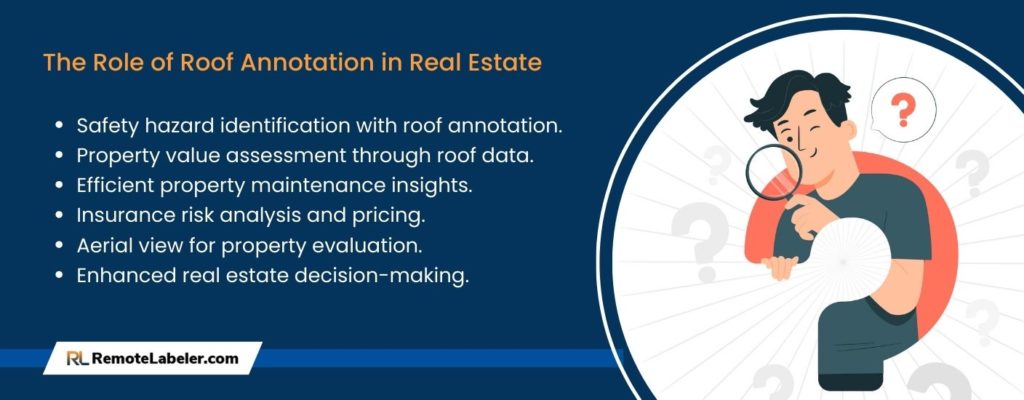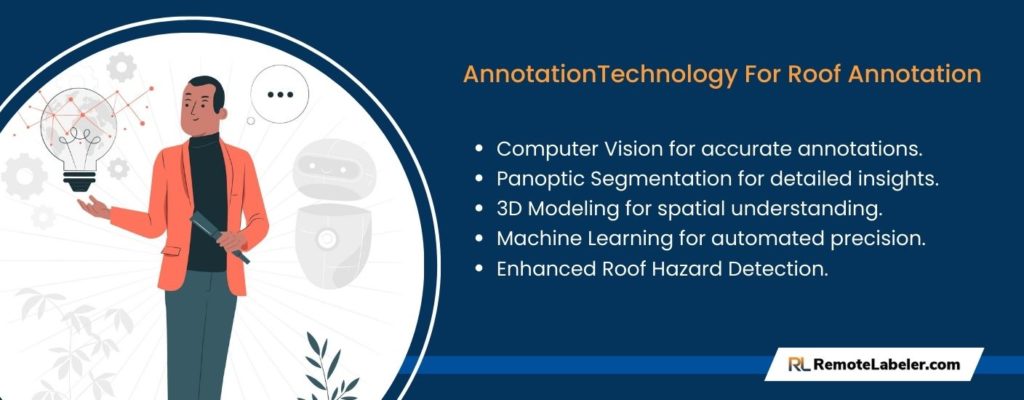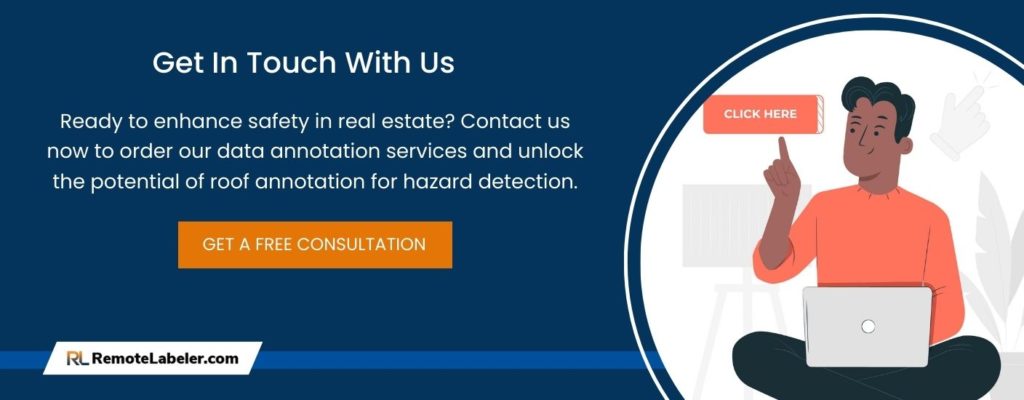The real estate industry, with its vast expanse of properties and structures, is no stranger to the myriad of challenges that come with ensuring safety. As potential homeowners or investors navigate this landscape, the structural integrity of properties, especially roofs, becomes paramount. Roof annotation, a specialized technique that involves detailed marking and analysis of roof images, emerges as a crucial tool in this context. By offering a granular view of roof conditions, it plays a pivotal role in highlighting potential hazards. With the expertise of remote data labelers, properties are ensured to not only meet aesthetic standards but also safety benchmarks.
The Role of Roof Annotation in Real Estate
Roof annotation serves as a beacon in the real estate industry, offering several key advantages:
- Detailed Imaging: Goes beyond traditional inspection methods to provide a comprehensive visual analysis of a roof’s condition, a crucial aspect of real estate data analysis.
- Identification of Minute Defects: Allows for the detection of subtle defects or potential problem areas that might be overlooked during standard visual inspections, showcasing the power of annotation in real estate.
- Assurance of Safety: Offers an added layer of safety assurance for real estate professionals, sellers, and buyers, emphasizing the importance of real estate labeling.
- Durability Check: Ensures that a property’s roof is not only functional but also durable, potentially saving future repair costs.
By leveraging advanced imaging techniques and data annotation tools, roof annotation provides a comprehensive analysis of a roof’s condition, ensuring that properties are both safe and durable, a testament to the importance of data analysis in real estate.

Common Roof Hazards in Real Estate:
Roofs, being the primary shield against external elements, are susceptible to a range of hazards. Recognizing and addressing these hazards is crucial, not just for the safety of the inhabitants but also for the longevity and value of the property, a key concern in commercial real estate labeling.
Structural Weaknesses
One of the most pressing concerns in roof safety is structural weaknesses. Common manifestations include sagging sections or uneven rooflines, which can be indicative of underlying issues like compromised support beams or inadequate roofing installation. Roof annotation, with its detailed imaging, can effectively identify these irregularities, providing a clear picture of areas that require immediate attention or repair.
Material Deterioration
Roofs, constantly exposed to the elements, are prone to material deterioration over time. Factors like extreme weather conditions, UV radiation, and natural wear and tear can lead to the degradation of roofing materials. Roof annotation can pinpoint areas of concern, such as missing tiles, worn-out shingles, or patches where the protective layer has been stripped away, ensuring timely interventions.
Water Damage and Leaks
Water damage, if unchecked, can have cascading effects on a property’s structure and overall value. Leaks can lead to mold growth, structural wood rot, and even damage to interior spaces. Roof annotation serves as a proactive measure, detecting signs of water damage, potential leak areas, or places where water might pool and cause long-term damage.
Moss and Fungal Growth
While moss or fungal growth on roofs might seem harmless or even aesthetically pleasing to some, they pose significant risks. Moss can trap moisture against the roof surface, accelerating wear and potentially leading to leaks. Similarly, unchecked fungal growth can deteriorate roofing materials. Roof annotation, with its precision, can identify these growths, ensuring they are addressed before they escalate into more significant issues.
With the expertise of remote data labelers, the real estate industry can harness the power of roof annotation to ensure the safety and longevity of properties, making it an invaluable tool in the realm of real estate data analysis.
The Technology Behind Roof Annotation
Roof annotation is more than just marking up images; it’s a sophisticated blend of technology and expertise that dives deep into the intricacies of roof structures. By leveraging state-of-the-art technologies, roof annotation provides detailed, accurate, and actionable insights into the condition of roofs. These technologies not only enhance the precision of inspections but also streamline the entire process, ensuring that potential hazards are identified and addressed promptly.

Computer Vision
At the heart of roof annotation lies computer vision, a field that enables machines to interpret and make decisions based on visual data. In the context of roof annotation in real estate, computer vision algorithms can automatically detect anomalies like cracks, wear, or water damage, providing a level of detail that might be missed by the human eye.
Panoptic Segmentation
Panoptic segmentation is a technique that classifies every pixel in an image, distinguishing between different objects and materials. In roof annotation, this technology can differentiate between roofing materials, identify areas of wear, or even detect subtle color changes that might indicate underlying damage.
3D Modeling
3D modeling allows for the creation of a three-dimensional representation of the roof. This provides a holistic view, enabling inspectors and property owners to visualize potential problem areas, understand the extent of damage, and plan repairs more effectively.
Machine Learning
Machine learning algorithms, trained on vast datasets, can predict potential areas of concern based on patterns and historical data. Over time, as these algorithms are exposed to more roof images, their accuracy and predictive capabilities improve, making them invaluable in real estate data analysis.
Introducing Remote Labeler: As a professional data annotation company, Remote Labeler boasts unparalleled expertise in annotation for the real estate industry. With a deep understanding of the unique challenges and requirements of this sector, Remote Labeler offers tailored solutions, ensuring that properties are analyzed with precision and care.

Benefits of Roof Annotation for Property Buyers and Owners
Roof annotation, with its blend of advanced technologies and meticulous analysis, offers a plethora of benefits to property buyers and owners. For buyers, it provides an added layer of assurance, ensuring that they’re making a sound investment. For property owners, it offers insights into maintenance needs, helping them preserve the value and safety of their property.
Key benefits include:
- Detailed Analysis: Roof annotation offers a granular view of the roof’s condition, highlighting even minute defects.
- Cost Savings: By identifying potential issues early on, property owners can undertake timely repairs, avoiding more costly interventions in the future.
- Safety Assurance: Roof annotation ensures that roofs are structurally sound, safeguarding inhabitants from potential hazards.
- Enhanced Property Value: A well-maintained roof, verified through annotation, can enhance the overall value of the property.
- Informed Decision Making: For buyers, roof annotation provides crucial data that can influence purchasing decisions, ensuring they invest in properties that are in good condition.
Conclusion
Roof annotation stands as a beacon of innovation and safety in the real estate industry. By leveraging advanced technologies like computer vision, panoptic segmentation, and machine learning, it offers detailed insights into the condition of roofs, ensuring that properties are safe, sound, and valuable. As the demand for data analysis in real estate grows, tools like roof annotation, championed by experts like Remote Labeler, will play an increasingly pivotal role.
Want to leverage roof annotation for your property? Reach out for advanced real estate labeling and elevate your journey with us.
- Emerging Trends and Future Outlook: The Data Labeling Industry in 2024-2030 - December 8, 2023
- Landmark Annotation: Key Points - November 6, 2023
- All You Should Know About Bounding Box Annotation - November 5, 2023